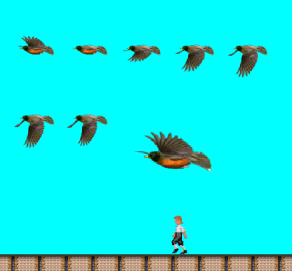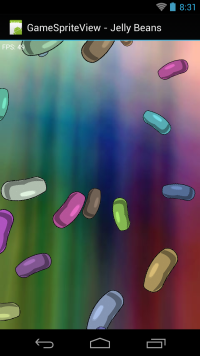Hi all,
This is my first attempt at creating a library so I hope it works.
It is a heavily modified version of the code Erel kindly posted for his GameView library.
03/02/2014 - v0.1
First Release
04/02/2014 - v0.2
Added FPS code to the GameSpriteView
12/02/2014 - v0.3
Removed the list-based system replacing it with a sub _Draw() call instead. Also added a convenient DrawText() command. Useful for displaying basic text messages (FPS monitoring).
16/04/2014 - v0.4
Changed: AnimDelayRate to AnimDelayTime. Now using milliseconds for timing.
Added: Filter to the Sprite class
Added: DeltaTime to the GameSpriteView class
GameSprite Library v0.4



GameSprite a very light-weight (10K) library designed with 2D games creation in mind. As the name suggests the library is geared towards sprite handling with a simple to understand command set.
The library features a powerful one-call animation command to set up automated animation.
Hardware acceleration is supported.
The key features are:
GameSpriteView methods and variables
You can get the library here, which includes some basic examples you get you started.
Included in the zip is an updated Pocket Invaders, which is a fully playable game to show-case the library.
DOWNLOAD LINK
Also now available, a companion tool written in B4J called SpriteMotion for assisting in the process of defining sprites contained within a sprite sheet.
This is my first attempt at creating a library so I hope it works.
It is a heavily modified version of the code Erel kindly posted for his GameView library.
03/02/2014 - v0.1
First Release
04/02/2014 - v0.2
Added FPS code to the GameSpriteView
12/02/2014 - v0.3
Removed the list-based system replacing it with a sub _Draw() call instead. Also added a convenient DrawText() command. Useful for displaying basic text messages (FPS monitoring).
16/04/2014 - v0.4
Changed: AnimDelayRate to AnimDelayTime. Now using milliseconds for timing.
Added: Filter to the Sprite class
Added: DeltaTime to the GameSpriteView class
GameSprite Library v0.4



GameSprite a very light-weight (10K) library designed with 2D games creation in mind. As the name suggests the library is geared towards sprite handling with a simple to understand command set.
The library features a powerful one-call animation command to set up automated animation.
Hardware acceleration is supported.
The key features are:
- GameSpriteView - the main display supporting virtual screen sizing, global rotation, global anchor point , get FPS, get DeltaTime
- Sprite - A bitmap-based object with positioning, anchor, size, flip, rotate, colour, alpha, animation, region support, basic collision (overlap) checking, and distance checking.
GameSpriteView methods and variables
IsHardwareAccelerated()
VirtualDisplaySize() , VirtualWidth() , VirtualHeight() , VirtualX() , VirtualY()
Anchor() , AnchorX , AnchorY
DrawText()
Rotate
FPS
Sprite methods and variablesVirtualDisplaySize() , VirtualWidth() , VirtualHeight() , VirtualX() , VirtualY()
Anchor() , AnchorX , AnchorY
DrawText()
Rotate
FPS
Bitmap
Position() , X , Y , CenterX , CenterY
Size() , ScaleSize() , Width , Height
Anchor() , MidAnchor, AnchorX, AnchorY,
Rotate , FlipX, FlipY
AnimDefineCells() , AnimSequence() , AnimCellRange() , AnimCellNumber , AnimDelayTime , AnimNextCell , AnimPreviousCell , AnimPlay
Region() , ResetRegion , CopyRegion()
isOver() , Overlaps() , DistanceTo()
ARGB() , RGB() , Alpha, Filter
Visible , Copy() , Reset
Position() , X , Y , CenterX , CenterY
Size() , ScaleSize() , Width , Height
Anchor() , MidAnchor, AnchorX, AnchorY,
Rotate , FlipX, FlipY
AnimDefineCells() , AnimSequence() , AnimCellRange() , AnimCellNumber , AnimDelayTime , AnimNextCell , AnimPreviousCell , AnimPlay
Region() , ResetRegion , CopyRegion()
isOver() , Overlaps() , DistanceTo()
ARGB() , RGB() , Alpha, Filter
Visible , Copy() , Reset
You can get the library here, which includes some basic examples you get you started.
Included in the zip is an updated Pocket Invaders, which is a fully playable game to show-case the library.
DOWNLOAD LINK
Also now available, a companion tool written in B4J called SpriteMotion for assisting in the process of defining sprites contained within a sprite sheet.
Last edited:
